Watering Tomatoes is both a Science and an Art
If you love gardening, you’ve probably already asked an expert or yourself this question: “How often should I water my tomato plants?” Don’t worry, you’re not alone in this quest. This guide has 100’s of people reading and sharing it each day.
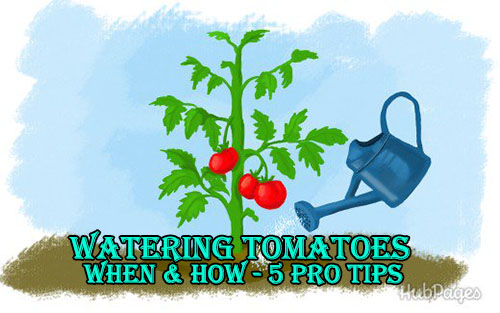
Plenty of people all across the globe take to tomato cultivation, not because tomatoes are relatively easy to grow and sustain; but the fact that they are used in plenty of different cuisines, in a variety of ways – more ways than you can ever imagine.
4 Facts about Tomato growth you need to know:
- Tomatoes are not magical – Tomatoes cannot be grown everywhere and not all through the year. There are plenty of tomato varieties to pick from. Speak to your local gardening club or neighbor to find out what grows best in the region.
- Sunlight is important – Tomato plants need sunlight in order to grow well. So, make sure that you place your plants in a sunny spot of your garden, not too hot though. Read on to know more about these settings.
- Nutrition – No matter how well you water, if the plants are not receiving the right nutrition, there isn’t really much you can do – apart from getting this problem fixed. Check your tomato plants for yellow leaves, as this is a sign of bad nutrition.
- Watering tomatoes – This is definitely a skill. But, it’s not rocket science and can easily be mastered. You could even teach your kids and maybe have them grow their own crop this season – it’s an amazing learning experience and a chance to bond.
Pour Water Directly onto the Soil – Not on the Plant
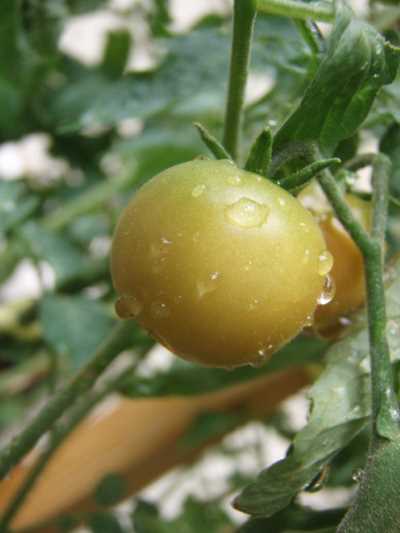
Before we proceed, I would like you to vote and see how often other people across the globe water their tomato plants. You could use the data to compare yourself with others and I’m sure that you will also be convinced that there is no single way to do it right.
But that’s nothing to worry about, as through this article I will teach you how to find out what works best for your locality. So put on your thinking cap and buckle up! The journey begins now.
An overview of what we will be covering:
- 5 Pro Tips on watering tomatoes
- Rain water for your plants.
- Caring for tomato plants when away.
- Using enlivened water.
- Watering tomato seedlings.
- How often to water tomatoes?
How to water Tomatoes – Tips to be mastered
As mentioned, watering tomatoes is an easy art to master. But, you’re not going to be able to do it the right way, unless you know what needs to be done. Trial and error is always the best way to learn something (if there are no risks involved), but use these tips to your advantage:
- Water Slowly – You need to allow time for the water to enter the soil, run away water is just a waste and it steals nutrients from the soil. Let water soak in at least 5 – 6 inches of soil.
- Water Regularly – Water twice a day to begin with, just moisten the soil (don’t flood the plant). The roots need air too, so don’t drown your plants.
- Water at the stem – Water at the base of the plant rather than the leaves. Try not to water directly on the stem as this brings up the roots of the plant.
- Water early in the day – if you use a hose, bucket or any other manual form of watering, it is recommended you do so in the early hours.
- Do not water in the night – Moist conditions and low temperatures increase the likelihood of tomato plant diseases.
- Mulch – Mulch acts as a moisture regulator and also a source of nutrition. Definitely give this a thought, if you don’e already implement it.
Pro Tip 1: Water Slowly
The main purpose of watering your tomato plants is to ensure that they have sufficient water to sustain themselves and perform their necessary physiological activities.
Therefore, when watering, you don’t want to flood the plant, only to have most of the water run off (with nutrients and top soil). Instead, you are going to need to water slowly, giving the water time to actually seep through the soil.
It is recommended that 6-8 inches below the soil is moistened when you water tomato plants as this stimulates root growth in this region, which is directly related to the amount of nutrients the plant can reach.
One thing that you could do is come up with your very own drip irrigation system. It’s not at all difficult and can be done at a very cheap price – under $2, in fact! Check out the video below for a sample irrigation system. When you use a drip irrigation system you ensure that the soil is moist all the time, but not flooded – this gives the roots room to breathe.
With reference to the video below: if you don’t want the bottle to hang up as shown (which can be unsightly for some) you could also place it below the soil, only keeping the opening above ground so that you could refill the bottle when needed.
Drip Irrigation System for Tomato Plants
Pro Tip 2: Water your Tomato plants regularly
First off, know that there’s no exact formula as to how often you should water your tomato plants. This is something that you’ll need to work out based on experience. All you need to do is regularly check on the soil a few days and see when it’s turning dry.
- If you’ve noticed it becoming dry really quickly, don’t be afraid. Instead, just try something new such as mulching or maybe a new method of watering — drip irrigation as mentioned numerous times already works best!
- In some regions you just need to water the plants once a day, whereas in other places you could end up watering them multiple times a day.
- There are also a few moist areas where merely watering once or twice a week is sufficient.
If you notice your tomato plant drooping sometime around mid-day, do not worry too much about it because they will be back to normal near sunset. But if they are still drooping after sunset, this is a sign that the ground is too parched and you would need to water. But only do this the next morning. (Refer: Pro Tip 1). There are problems associated with watering tomato plants in the night. (Refer: Pro Tip 4).
Plants drooping in the sunlight isn’t always because of a lack of water, it is also a reflex mechanism developed so that the plants minimize surface area in contact with the direct sunlight, which in turn reduces transpiration (loss of water from the leaves, etc.) or in simple terms evaporation.
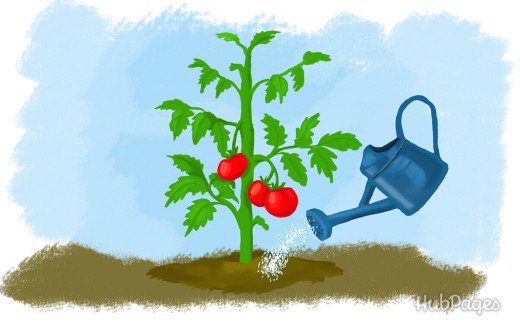
Pro Tip 3: Water Tomato plants at the roots
If you have a habit of watering plants with a hose, it’s very likely that you are also watering the leaves of the plant, instead of pointing the hose to the ground around the stem. Some of us have the tendency to water on the leaves as this makes the plants look better 😉
If by chance you do want to water on the leaves, make it a point that you water the plants early in the morning, before the sun is up. If your water supply isn’t pure – if it is hard water or you’ve mixed in fertilizer (organic or chemical) I suggest you stop watering on the leaves, as this just damages them, preventing optimal functioning and food preperation when the sun shines.
Important: Watering on the leaves and fruits increases the likelihood of tomato plant diseases. Water on the leaves at your own risk. (Refer: Pro Tip 4)
As already mentioned earlier, when I say watering at the roots, this does not necessarily mean watering directly on the ground near the stem. It’s best to do it a few inches away around the stem (form a circle around the stem) as this will not wash away soil near the stem which is very important, especially if you do not have external support for your tomato plants.
You could also use Tomato Craters as seen below. They are really helpful in a sense that they let water seep into the ground slowly, you don’t need to reduce the flow rate from the garden hose anymore. They also suppress the growth of weeds around the tomato plants. Moreover, they are red and reflect some of the sun light back onto the plant which helps with photosynthesis as per some studies.
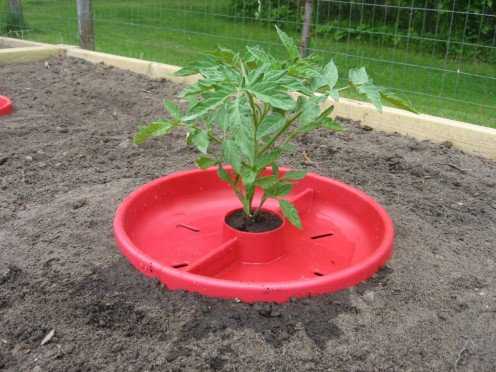
Pro Tip 4: Do not water your Tomato plants in the night
As stated earlier, watering on the leaves and fruit can increase the likelihood of some tomato plant diseases. But you may ask the dreadful question: Why!?
It’s quite straightforward really, most of the tomato plant diseases are a threat under moist conditions. But this isn’t the only necessary condition for the disease to foster and thrive. They also need relatively low temperatures.
So putting two and two together, it is obvious that you shouldn’t water your tomato plants in the night, even if they seem droopy.
Pro Tip 5: Mulching
In case you do not know what mulch is, it is an organic layer of leaves, hay, coconut husk, wood pieces or pine cone pieces. There are plenty of other forms too, if interested Google it. Since it’s organic, it would decay over time and also be a source of nourishment for the plants.
Mulching has quite a few benefits, the main ones being:
- Water retention
- Increased room for aeration when lightly mixed with the top soil
- Source of nourishment
If you mulch your plants well, you’re not going to need to water them as often, since the rate of evaporation from the soil is drastically reduced. So, when you mulch you may end up watering just once a day if you were previously doing it twice or more times a day.
If you don’t already have mulch, you may want to check this coconut husk mulchout. It lasts for really long and is my best choice. I do not buy my mulch as coconut husk is easily available, my home being in a tropical location.
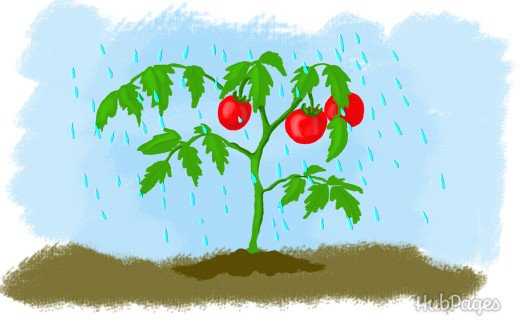
Rain water is the best for plants
Rain water is the best for plants as it’s natural and has no added chemicals during the processing stages. Moreover, if you’ve got hard water in your region, the salts are not the best for your tomato plants or any other plants for that matter.
If you do happen to have a rain water harvesting system at home and an underground storage, one of the best ways to make use of this water is in your garden. Give it a shot and you would see improvements, if you’ve already been gardening for a while.
How to water Tomato plants while on vacation
How do I water my plans if I’m out of town? This a common question you’ll come across, as we all need to go on vacation some time or another and we can’t just leave our gardens to dry up. Most of us have neighbors who would be willing to help, but not all of us are that lucky.
So the best options would include:
- Programmed Drip Irrigation Systems: These aren’t expensive to install and are also very easy to operate and maintain. Therefore, if you go on vacation often or don’t have the time to water your garden yourself, you could program it to water your plants everyday at a particular time. Check the video above for a simple super low budget drip irrigation system.
- Placing plants in a basin of water: If your plants are in pots, you can always place the pots in a basin of water. Make sure that the plant is above the level of the water as you don’t want to flood it. Water will enter through the exit hole, via capillary action. Make sure there is sufficient leverage between the pot and water as you do not want to flood the roots either.
- Mulch: If you’re taking a short trip (3-4 days), you could solely depend on your mulch to keep the plants alive and healthy until you return. Again this depends on the local conditions, but this is a ball park figure that works well in most cases.
Watering Tomato plants using enlivened water
Enlivened water is an ancient method wherein the water is stirred clockwise, about 40-50 times and then the plants are watered.
While it is an ancient method, modern science has backed this method, as spiraling water gains energy, since it’s in motion. Watering tomatoes with this water does make them grow healthier according to some studies.
I’m not an advocate of this method and I’ve not tried it out as I find it “crazy“, but that’s just me. Maybe you’ve tried it out in your garden or heard about it somewhere? If yes and you have something to say about it, please do leave a comment below.

Watering Tomato Seedlings
Watering tomato seeds and seedlings is a whole different story. Germinating tomato plants from seeds is a very simple process, but you only see the best results when done right. Since this is the first step of the tomato plants growth, you are going to want to make sure your plants get the right start.
I’ve already written another article on how to plant tomato plants from seeds, you may want to check it out.
When it comes to watering tomato seedlings, there is no better tutorial than this video I’ve just found on YouTube:
How often to water tomatoes?
How often you water tomatoes is a major concern most people face, especially the first time around. It is important to have the soil moist, not flooded. The soil needs to be damp at least 6 – 8 inches below the ground to stimulate root growth. Watering once a day works best for most regions.
In case you aren’t sure, begin by watering once a day and go from there. The tips above are definitely going to guide you and would help you make informed decisions rather than random guesses.
If you fail to water tomato plants the right way, it could lead to various issues:
- Diseases, including root loss, blossom end rot, and others
- Reduced fruit production
- Stunted growth
- Decreased resistance
It should go without saying, that knowing how to water tomato plants properly is the most important skill when it comes to growing tomato plants. Adding the right fertilizers at the right stage of growth is probably the second most important, else you would have foliage and not many fruits.
Source : dengarden.com
Want to be as self-sufficient as possible? Want to master all the lost skills our grandfathers had? Then you really need this amazing step-by-step guide. It is called The Lost Ways and it contains all the knowledge of our forefathers.
Here’s just a glimpse of what you’ll find in The Lost Ways:
From Ruff Simons, an old west history expert and former deputy, you’ll learn the techniques and methods used by the wise sheriffs from the frontiers to defend an entire village despite being outnumbered and outgunned by gangs of robbers and bandits, and how you can use their wisdom to defend your home against looters when you’ll be surrounded.
Native American ERIK BAINBRIDGE – who took part in the reconstruction of the native village of Kule Loklo in California, will show you how Native Americans build the subterranean roundhouse, an underground house that today will serve you as a storm shelter, a perfectly camouflaged hideout, or a bunker. It can easily shelter three to four families, so how will you feel if, when all hell breaks loose, you’ll be able to call all your loved ones and offer them guidance and shelter? Besides that, the subterranean roundhouse makes an awesome root cellar where you can keep all your food and water reserves year-round.
From Shannon Azares you’ll learn how sailors from the XVII century preserved water in their ships for months on end, even years and how you can use this method to preserve clean water for your family cost-free.
Mike Searson – who is a Firearm and Old West history expert – will show you what to do when there is no more ammo to be had, how people who wandered the West managed to hunt eight deer with six bullets, and why their supply of ammo never ran out. Remember the panic buying in the first half of 2013? That was nothing compared to what’s going to precede the collapse.
From Susan Morrow, an ex-science teacher and chemist, you’ll master “The Art of Poultice.” She says, “If you really explore the ingredients from which our forefathers made poultices, you’ll be totally surprised by the similarities with modern medicines.” Well…how would you feel in a crisis to be the only one from the group knowledgeable about this lost skill? When there are no more antibiotics, people will turn to you to save their ill children’s lives.
And believe it or not, this is not all…
Table Of Contents:
Making Your Own Beverages: Beer to Stronger Stuff
Ginger Beer: Making Soda the Old Fashioned Way
How North American Indians and Early Pioneers Made Pemmican
Spycraft: Military Correspondence During The 1700’s to 1900’s
Wild West Guns for SHTF and a Guide to Rolling Your Own Ammo
How Our Forefathers Built Their Sawmills, Grain Mills,and Stamping Mills
How Our Ancestors Made Herbal Poultice to Heal Their Wounds
What Our Ancestors Were Foraging For? or How to Wildcraft Your Table
How Our Ancestors Navigated Without Using a GPS System
How Our Forefathers Made Knives
How Our Forefathers Made Snow shoes for Survival
How North California Native Americans Built Their Semi-subterranean Roundhouses
Our Ancestors’Guide to Root Cellars
Good Old Fashioned Cooking on an Open Flame
Learning from Our Ancestors How to Preserve Water
Learning from Our Ancestors How to Take Care of Our Hygiene When There Isn’t Anything to Buy
How and Why I Prefer to Make Soap with Modern Ingredients
Temporarily Installing a Wood-Burning Stove during Emergencies
Making Traditional and Survival Bark Bread…….
Trapping in Winter for Beaver and Muskrat Just like Our Forefathers Did
How to Make a Smokehouse and Smoke Fish
Survival Lessons From The Donner Party
Get your paperback copy HERE
CHECK OUR survival and prepping solutions
If you found this article useful, please like our Facebook page and stay up to date with the latest articles.
WHAT TO READ NEXT:
HOW TO MAKE YOUR OWN BACON (STEP BY STEP GUIDE)
A RETURN TO THE OLD PATHS: HOW TO MAKE PEMMICAN LIKE THE NATIVE AMERICANS
20 LOST RECIPES FROM THE PIONEERS: WHAT THEY COOKED ON THEIR JOURNEY WESTWARD
SEVEN CLASSIC GREAT DEPRESSION ERA RECIPES GRANDMA USED TO MAKE
POTTED MEAT: A LOST SKILL OF LONG TERM MEAT STORAGE
BACK TO BASICS: HOW TO MAKE AND PRESERVE LARD
THE BEST WAY TO STOCKPILE VEGETABLES OFF-GRID
OLD FASHIONED PRESERVING-GRANDPA’S RECIPE FOR CURED SMOKED HAM
HOW TO MAKE GUNPOWDER THE OLD FASHIONED WAY
SURVIVAL HERBAL RECIPES FROM OUR ANCESTORS
HOW TO PRESERVE MEAT FOR SURVIVAL LIKE OUR GRANDFATHERS
OTHER USEFUL RESOURCES:
The 3 Pioneer Survival Lessons We Should Learn
The Most Effective Home Defense Strategies
Old School Hacks for Off-Grid Living
The Medical Emergency Crash Course
The Smart, Easy Way to Food Independence
How to Survive the Coming 100 Years Long Drought
